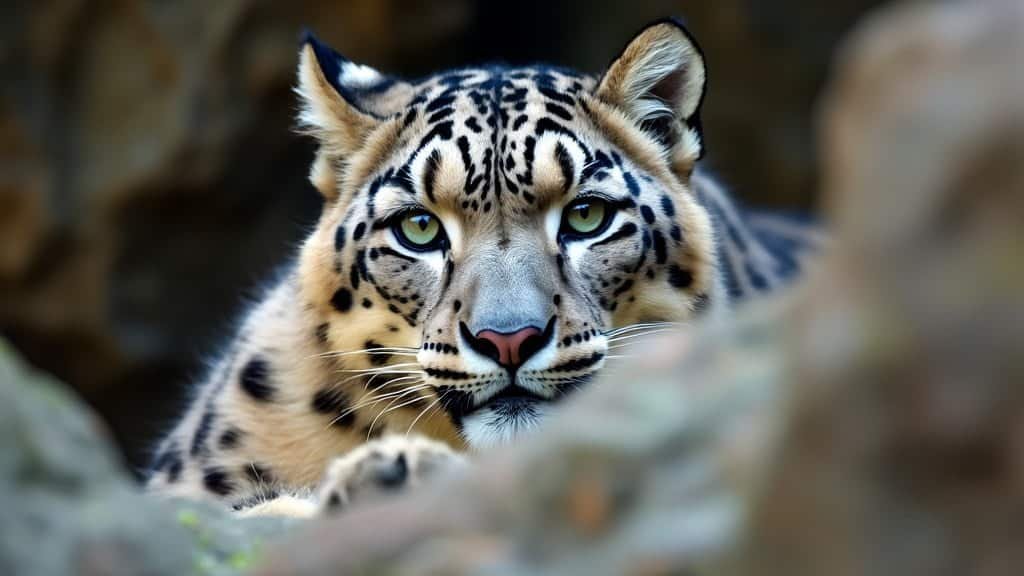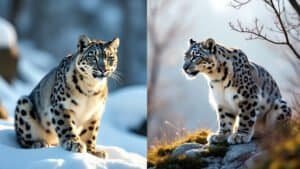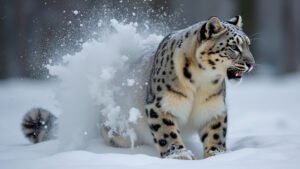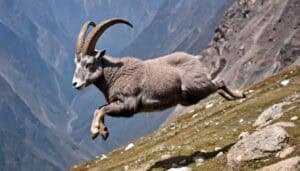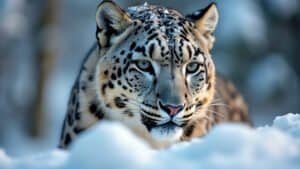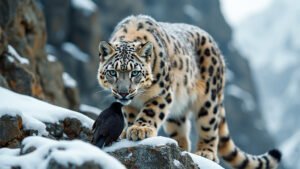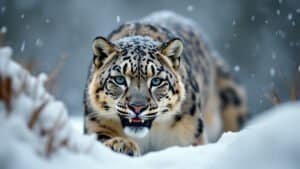Introduction
Snow leopards are among the most elusive big cats in the wild, known for their remarkable ability to stalk and ambush prey. This article explores the strategies snow leopards use to remain undetected, from their expert use of camouflage to the way they leverage the rugged terrain of their habitats
We will also examine how their physical adaptations and behavioral tactics play a crucial role in their hunting success. Finally, we will discuss how snow leopards adjust their strategies based on the type of prey they are targeting
By understanding these fascinating techniques, we gain insight into the survival strategies of these magnificent predators
How Snow Leopards Use Camouflage for Stalking
Snow leopards are masters of stealth in their mountainous habitats, relying heavily on their natural camouflage to get close to their prey without being detected
Their distinctive coat, blending perfectly with the rocky and snowy terrains of Central and South Asia, is a critical asset in their hunting arsenal. By understanding how snow leopards use camouflage, we can appreciate the intricate strategies these predators employ to ensure their survival in such challenging environments
Natural Fur Patterns for Blending In
The snow leopard’s thick, dense fur is patterned with rosettes and spots that mimic the rocky outcrops and snow-covered landscapes of their habitat. This natural patterning allows them to seamlessly blend into their surroundings, making them almost invisible to both prey and potential threats
Research has shown that these rosettes are not just randomly placed; they are specifically adapted to break up the outline of the leopard’s body, which is crucial when stalking prey in an open or semi-open environment
This form of disruptive coloration is similar to that used by military forces, where it disrupts the visual perception of a predator or prey, effectively “breaking” the body shape into the background
Additionally, the color of a snow leopard’s coat varies slightly depending on the season. In winter, their fur becomes thicker and slightly paler, which provides better camouflage against snow, while in summer, their fur is shorter and may have a more yellowish tint to blend with the bare rocks
This seasonal adaptation ensures that snow leopards remain hidden regardless of the time of year
Using Shadows and Terrain to Stay Hidden
Camouflage goes beyond just fur color and patterns; snow leopards also use the terrain to their advantage. They are known to move along ridgelines, stay within shadows, and use rocks and boulders to mask their movements
This behavior is particularly evident during daylight when the sun casts long shadows, providing natural cover for a stalking snow leopard. By hugging close to rocks or moving within the shade, snow leopards reduce the likelihood of being seen by their prey
The effectiveness of this strategy is enhanced by their low profile and silent movement. Snow leopards have powerful yet nimble bodies that allow them to move quietly across rocky terrain, avoiding loose stones and debris that could give away their presence
This, combined with their natural fur patterns, makes them nearly undetectable as they approach their prey
Seasonal Camouflage Changes
Snow leopards live in a range of altitudes, from high, snow-covered peaks to lower, more barren, rocky slopes. To adapt to these varying environments, their fur changes with the seasons, not only in color but also in density and length
During the winter, when snow is more prevalent, the leopard’s fur becomes denser, longer, and lighter. This adjustment is not just for warmth but also for effective concealment. The longer, paler fur allows them to blend seamlessly into snow-covered rocks and ice
Conversely, during the warmer months, the snow leopard’s fur becomes shorter and slightly darker. This change helps them blend into the exposed rocks and barren landscapes that characterize their summer environment
The ability to adapt their appearance according to the season allows snow leopards to maintain a level of concealment essential for stalking prey year-round, regardless of the environmental conditions
Leveraging Terrain for Ambushes
Snow leopards thrive in rugged, mountainous terrains, where steep cliffs, rocky outcrops, and narrow valleys provide them with perfect ambush sites
These natural features not only help them remain hidden but also give them strategic advantages when launching an attack. By using the terrain to their benefit, snow leopards can effectively stalk, surprise, and overpower their prey
Choosing High Ground for Visibility
One of the key tactics snow leopards use is choosing high ground. From elevated positions, they have a clear vantage point to spot potential prey from a distance. This tactic allows them to stay out of sight while monitoring their surroundings and planning their approach
Studies have shown that snow leopards often prefer ridges, cliffs, and ledges because these spots provide both a broad field of vision and concealment from prey below
This high ground strategy is effective for a few reasons. First, it enables snow leopards to assess their environment, identifying the movement patterns of prey and the presence of any potential threats
Second, it allows them to choose the most optimal path to approach their target, minimizing the chance of detection. By staying above their prey, snow leopards can use gravity and surprise to their advantage, quickly closing the distance when they decide to strike
Utilizing Rocky Outcrops and Cliffs
Rocky outcrops, cliffs, and steep terrain are also prime features that snow leopards exploit for ambushes. These natural formations provide excellent cover as they allow the leopard to remain hidden while stalking or waiting for the right moment to pounce
Snow leopards are incredibly agile and are known for their ability to navigate these difficult landscapes with ease. Their powerful hind legs enable them to leap as far as 50 feet in a single bound, which can be crucial when launching an attack from an elevated position
Additionally, rocky terrains offer narrow and unpredictable paths that prey often traverse. Snow leopards utilize these natural bottlenecks to trap prey, reducing their options for escape
The rugged landscape forces prey animals, such as blue sheep or ibex, to move along certain routes, making them vulnerable to surprise attacks from snow leopards waiting in ambush
Strategic Positioning Near Prey Paths
Snow leopards have an incredible understanding of their environment and often position themselves along the most likely paths that prey will take
These paths are often determined by natural features such as water sources, ridgelines, or game trails. By positioning themselves along these routes, snow leopards maximize their chances of encountering prey
This strategic positioning allows them to conserve energy while waiting for the right opportunity to strike
Unlike many other big cats that might rely on lengthy chases, snow leopards are ambush predators, meaning they depend on close proximity and a quick, powerful attack. By being patient and utilizing natural terrain features, they increase their hunting success rate significantly
Snow leopards also use the natural sounds of their environment to mask their movements. The sound of rushing water, wind, or falling rocks can help drown out the noise of their approach, making their ambush tactics even more effective
In such a challenging environment, every advantage counts, and snow leopards have evolved to use these features to the fullest extent
Physical Adaptations for Stealth and Precision
Snow leopards possess unique physical traits that make them highly effective stalkers and ambush predators
Their bodies are perfectly adapted to the challenging environments of the high-altitude mountains, allowing them to move silently, maintain balance on steep terrain, and execute rapid, powerful attacks with great precision
These physical adaptations are essential for both stalking prey undetected and delivering a successful ambush
Muscular Build for Silent Movement
The muscular build of snow leopards is one of their key adaptations for stealth. Their bodies are powerfully built but lean, which provides the strength needed for swift, quiet movements over rugged terrain
Unlike many other big cats, snow leopards have relatively short forelimbs and long, muscular hind limbs. This configuration enables them to make high and long leaps—crucial for crossing gaps between rocks or jumping down from elevated positions during an ambush
Their powerful muscles also help them move slowly and carefully when stalking prey. By keeping their center of gravity low and placing their paws softly on the ground, they can minimize noise and avoid dislodging loose rocks that might alert prey to their presence
This muscular coordination is an advantage in their mountainous habitat, where loose stones and uneven surfaces make stealthy movement challenging
Long Tail for Balance and Quick Turns
The snow leopard’s long, thick tail is another critical adaptation that aids in both stalking and ambushing. This tail, which can be nearly as long as the leopard’s body, serves multiple purposes
Firstly, it provides exceptional balance when navigating narrow ledges, steep slopes, and rocky terrain. When stalking prey or lying in wait on precarious terrain, maintaining balance is crucial for avoiding detection and ensuring a successful pounce
Secondly, the tail aids in making rapid, agile turns during a chase or ambush. When snow leopards launch an attack, they often have to maneuver quickly to keep up with the fleeing prey or to adjust their position
The tail acts like a rudder, helping them make sharp turns without losing momentum. This is particularly useful in the uneven and unpredictable landscapes they inhabit, where quick directional changes can make the difference between catching a meal and missing an opportunity
Padded Paws for Quiet Steps
The snow leopard’s paws are specially adapted for moving silently and efficiently in their rugged environment. Their large, fur-covered paws act like natural snowshoes, distributing their weight more evenly to prevent sinking into snow and to move quietly over hard, uneven surfaces
The pads of their feet are also thick and cushioned, which helps to soften their steps, allowing them to approach prey without being heard
These padded paws are not only useful for silence but also for traction. Snow leopards live in areas where ice, snow, and loose rock can make footing treacherous
The fur on the bottom of their paws provides insulation against the cold and additional grip, enabling them to navigate slippery slopes or chase prey over snow-covered terrain without slipping. This adaptation is crucial for maintaining stealth and stability, especially when making the final approach toward their target
The combination of muscular build, a long tail, and specially adapted paws equips snow leopards with the physical capabilities needed to stalk and ambush prey successfully
These adaptations are a testament to their evolutionary development, finely tuned for survival in some of the world’s most challenging environments
Behavioral Tactics in Stalking and Ambushing Prey
Snow leopards are not just physically adapted for stalking and ambushing; they also exhibit a range of sophisticated behavioral tactics that make them effective predators
These behaviors involve patience, careful timing, and precise movements, all of which increase their chances of a successful hunt in the harsh and unpredictable terrain they call home
Patience and Timing in Stalking
Patience is a hallmark of a snow leopard’s hunting strategy. Unlike other predators that may actively chase down their prey, snow leopards rely on waiting for the perfect moment to strike
They can spend hours or even days observing their prey from a distance, analyzing patterns of movement, and waiting for the ideal conditions. This patience minimizes energy expenditure, which is crucial in the snow leopard’s high-altitude environment where prey is often scarce
The timing of an attack is equally important. Snow leopards often prefer dawn or dusk, known as crepuscular hours, when there is limited light and their prey is less alert
During these times, their natural camouflage is most effective, and their chances of being detected are significantly reduced. This behavior showcases their ability to understand the rhythms of their environment and use them to their advantage
Slow and Calculated Movements
When stalking prey, snow leopards move with extreme caution, employing slow and calculated movements to avoid detection. They keep a low profile, minimizing their silhouette against the landscape
Every step is deliberate, as a single misstep that dislodges a stone or creates an unusual sound could alert prey and ruin the chance for a successful ambush. This slow approach can take hours as the leopard inches closer to its target
Moreover, snow leopards are known to use zigzag patterns or move in indirect routes to get closer to their prey. By doing this, they can approach from a direction where the prey is less likely to detect them, such as upwind or from a blind spot created by rocks or vegetation
This tactic demonstrates their ability to plan and execute complex stalking strategies that increase their hunting success rate
Immediate Actions Before an Ambush
Just before launching an ambush, snow leopards often pause to assess their final approach and ensure everything is in their favor
This pause is crucial—it allows them to gather their strength, fix their gaze on the target, and make any last-minute adjustments. During this moment, they remain perfectly still, relying on their camouflage to remain unseen
Once they decide to attack, snow leopards spring into action with explosive speed and agility. Their powerful hind legs propel them forward, covering ground quickly to close the gap between themselves and their prey. They aim for a quick and decisive kill, often targeting the throat or the neck of the prey to immobilize it instantly
If the initial pounce does not result in a kill, snow leopards are capable of short but intense chases to secure their catch. However, these chases are usually brief, as snow leopards rely more on the element of surprise than endurance
These behavioral tactics, combined with their physical adaptations, make snow leopards highly efficient hunters capable of thriving in one of the most challenging environments on Earth
Adapting Strategies Based on Different Prey
Snow leopards are opportunistic hunters, capable of adapting their stalking and ambushing strategies based on the type and behavior of the prey they target
The diversity of prey in their mountainous habitats—from small rodents to large ungulates—requires them to modify their approach, tactics, and even hunting style to maximize their chances of success. Understanding these adaptations provides insight into the snow leopard’s flexibility as a predator
Adjusting Tactics for Small vs. Large Prey
When hunting small prey, such as marmots, hares, or rodents, snow leopards employ a quicker and more direct approach
Since these smaller animals are highly alert and capable of rapid escape, the leopard minimizes its stalking time and pounces swiftly, relying on speed and agility to catch the prey before it can flee. This strategy often involves sneaking up as close as possible and launching a sudden, short-distance ambush
Conversely, when targeting larger prey like blue sheep (bharal), ibex, or Himalayan tahr, snow leopards need a more calculated and patient strategy. These ungulates are typically found in herds and are more vigilant, requiring the snow leopard to carefully analyze the terrain and wind direction to avoid detection
The approach is slower and involves positioning on higher ground or behind rocks, waiting for the right moment when a weak or isolated individual strays from the group. This patience and strategic planning allow snow leopards to conserve energy and increase the likelihood of a successful ambush
Adapting to Seasonal Changes in Prey Behavior
Snow leopards also modify their hunting strategies based on seasonal changes, which can affect prey availability and behavior. For example, during the summer months, prey like ibex and blue sheep may move to higher altitudes to graze on fresh vegetation, requiring snow leopards to follow them to these elevated terrains
In contrast, during the winter, these same prey animals may descend to lower altitudes where food is more accessible, influencing the snow leopard to adjust its stalking grounds accordingly
Seasonal adaptations also extend to how snow leopards use the environment to their advantage. In winter, with more snow cover, snow leopards can use their fur’s camouflage more effectively and take advantage of slippery slopes to corner prey
In summer, when vegetation is more abundant, they might use foliage to hide their movements more effectively. These seasonal behavioral adjustments are crucial for survival in an environment where prey dynamics can change rapidly
Group Hunting vs. Solitary Hunting
While snow leopards are predominantly solitary hunters, there are instances where they may engage in group hunting, particularly when a mother is teaching her cubs how to hunt
During these times, the strategies become more complex, as the mother snow leopard demonstrates stalking and ambushing techniques, guiding the cubs to approach quietly and learn how to make a kill
This group dynamic is more of a learning process for the cubs than a cooperative hunting strategy, but it showcases the flexibility and adaptability of snow leopards
Moreover, when hunting larger prey, snow leopards may attempt to drive the prey toward a natural obstacle, such as a cliff or steep slope, where escape is difficult. By using the terrain to corner or trap prey, snow leopards reduce the chances of a prolonged chase, conserving energy for the kill
These tactics reflect an understanding of the landscape and prey behavior, further highlighting the snow leopard’s adaptability as a predator
These adaptive strategies enable snow leopards to efficiently hunt a wide variety of prey across different terrains and seasons, showcasing their versatility and intelligence in the wild
Conclusion
Snow leopards are extraordinary predators, expertly adapted to the harsh and rugged terrains of the mountainous regions they inhabit. Their success in stalking and ambushing prey comes from a combination of physical adaptations, such as their powerful muscles, long tails, and padded paws, which allow for silent and agile movement
Moreover, their use of natural camouflage, patience, and strategic positioning helps them remain undetected as they approach their prey. The behavioral tactics they employ—careful timing, calculated movements, and the ability to adapt their hunting strategies based on different prey and environmental conditions—demonstrate their intelligence and versatility as hunters
Whether leveraging the terrain for ambushes or adjusting their strategies for different prey types and seasons, snow leopards exemplify the art of survival in one of the world’s most challenging environments. Their remarkable hunting skills ensure they remain one of nature’s most formidable and elusive big cats
